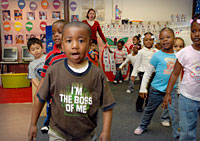Take a Deep Breath
September 10, 2008 - Head Start teacher Janet Luckey was struggling to open a thick envelope of classroom materials one morning. Her students, ages 3 to 5, knew just what to do. "Don't get frustrated, Mrs. Luckey," they advised. "Go get some scissors."
Luckey laughs, remembering. Coping with frustration was one of the behavioral skills she'd been teaching her preschoolers as part of GSE's innovative EPIC program. Now her students were teaching her.
 Ask a four-year old in an EPIC classroom about frustration and he'll tell you, "Take a break and take a deep breath." Ask a pair of five-year-olds rolling out circles of Play-Doh what they're up to, and they'll respond: "We're working together to get the job done."
Ask a four-year old in an EPIC classroom about frustration and he'll tell you, "Take a break and take a deep breath." Ask a pair of five-year-olds rolling out circles of Play-Doh what they're up to, and they'll respond: "We're working together to get the job done."
Emotional and social behaviors are "skills that can be taught," says Penn GSE Professor John Fantuzzo, principal investigator for the Evidence-Based Program for the Integration of Curricula (EPIC). Tested for the past five years in 40 Head Start classrooms in Philadelphia, EPIC is based on the hypothesis that focusing on preschoolers' social, emotional, and behavioral development will make them more resourceful and resilient learners.
Living in poverty and underserved urban neighborhoods, low-income preschool children are disproportionately at risk for developmental lags and poor school performance. In traditional Head Start classrooms, says Fantuzzo, teachers "teach" the alphabet, counting, and other basic pre-literacy and numeracy skills while they "manage" the behaviors and social interactions that distract from that teaching. EPIC instead integrates the social, emotional, and cognitive into one comprehensive and stimulating classroom program. When EPIC teachers sit down to read Eric Carle's The Very Busy Spider, for example, they are not just building vocabulary or listening comprehension, they are presenting a lesson in attention and self control.
The teachers, who form a unique Learning Community integral to the development and success of EPIC, give the program highest praise. "This is the first time in my career that I've been excited about the curriculum," says Luckey, a 34-year Head Start veteran.
Excitement abounds in an EPIC classroom, where every inch of wall and floor space is alive with colorful details, purposefully chosen and displayed, from the picture books to the giant cut-out light bulb proclaiming "I have an idea" to the artwork the kids have made with their families. That artwork, by the way, represents an essential component of the EPIC approach: a connection between classroom and home.
And just as EPIC erases distinctions between children's emotional and cognitive development, the curriculum also eliminates boundaries between instructional time and the "transitions" — the line-ups, bathroom breaks, coat donning and doffing — that devour so much precious time in the preschool day. EPIC fills these usually wasted moments with fun activities that reinforce lessons about numbers and letters. Also integrated into the curriculum are weekly Check-Ins, a tool that lets teachers assess the progress of each individual child and, says one teacher, "see how we're doing in real time."
In the process of creating a curriculum based on their own experiences and knowledge, EPIC teachers, just like their young students, themselves feel better equipped to handle the frustrations of teaching children growing up in the most difficult of circumstances.
"Before I used to get discouraged," says Susan Whittaker, of her 11 years with Head Start. EPIC, she says, "has given me hope."
